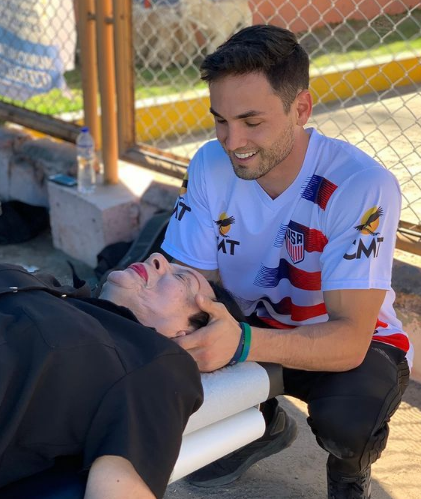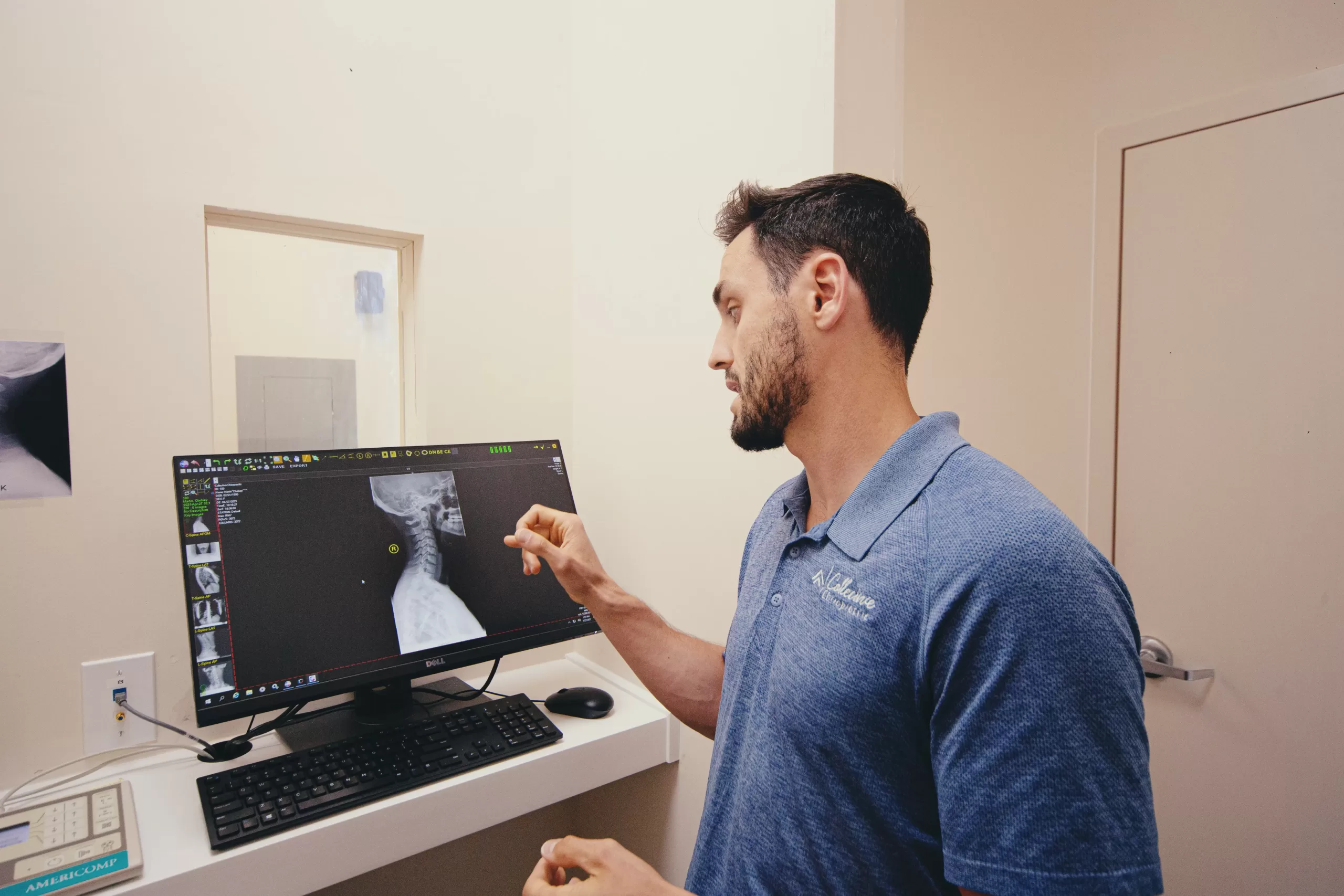Knee pain is a common complaint among adults of all ages and activity levels. The knee joint takes on a lot of stress from everyday activities such as walking, running, and climbing stairs. Athletes put even more strain on the knee with physical activities like jumping, kicking, and twisting motions.
Chiropractic care for knee pain focuses on restoring proper alignment and balance in the knee joint itself, as well as providing relief from the underlying symptoms. Chiropractors utilize a range of treatments including soft tissue manipulation, joint mobilization, ultrasound therapy, cold laser therapy, and electrical stimulation. The goal is to reduce inflammation and pain while improving range of motion and mobility.
Chiropractic adjustments are also beneficial for other conditions that may be indirectly affecting the knee such as sciatica or tight hip flexors which can pull on the knee forcing it out of its proper position.
For those suffering from chronic knee pain, chiropractic care can help provide much needed relief. If you’re looking for an alternative to medication or surgery, chiropractic care could be the answer you’ve been searching for.
Types of Knee Pain
For those of us that are athletically inclined, ankle pain is an all too familiar feeling. Whether it’s from a sprain or injury, tendonitis, fracture, or bursitis, there are many types of common ankle ailments to be aware of.
Sprain/Injury
Knee sprain/injury is a common injury that results from damaging the ligaments or tendons surrounding the knee joint. The injury can range from mild stretching of the ligaments to a complete tear involving one or more of the four major ligaments in the knee.
Whether it is due to sports-related injuries, traumatic accidents, or arthritis, knee pain can have a serious impact on your quality of life. Fortunately, chiropractic care offers an effective solution for many suffering from burning knee pain.
Chiropractic treatment focuses on correcting the alignment and movement patterns of your bones and joints which are often the root cause of sudden knee pain. By restoring proper biomechanics to the affected area with manual adjustments, chiropractors can decrease inflammation and improve range of motion in the joint – both of which are critical for reducing discomfort and speeding up recovery time after injury or surgery.
For athletes in particular, regular chiropractic care can help prevent sports-related injuries by keeping joints properly aligned and balanced. It can also aid in a speedy recovery after an accident or sprain since chiropractic therapy helps to reduce inflammation and increase blood flow, which leads to faster healing of strained muscles and ligaments.
Tendonitis
Tendonitis is a type of knee pain that can be caused by certain repetitive motions or activities. This can include sports-related activities such as running, jumping, and kicking, but also everyday activities like walking, climbing stairs, and even sitting in the same position for too long.
Symptoms include sharp pain when moving the affected joint or area, swelling around the knee joint, tenderness to touch, and difficulty with range of motion. If not addressed properly, tendonitis can lead to severe knee pain and permanent damage to the tendons.
treatment usually includes taking anti-inflammatory medications or steroid injections and avoiding any activities that may have caused it in the first place. Physical therapy is often prescribed to help strengthen the weakened muscles surrounding the joint , increase range of motion, and reduce inflammation.
The most effective way to treat knee pain due to tendonitis is through chiropractic care. Chiropractors use a combination of physical manipulations as well as targeted exercises and stretches to help the patient regain strength and flexibility in the affected area. Manipulating the joint can help reduce any existing swelling while also improving mobility and reducing pain. In addition, many chiropractors will recommend specific dietary changes to further reduce inflammation and speed up recovery.
Fracture
A knee fracture occurs when the bones surrounding the knee joint are broken, resulting in severe pain, swelling, stiffness and other symptoms like inability to bear weight or move the leg normally.
If you have suffered a knee fracture, your doctor may suggest surgery to put back together the broken pieces of bone. Surgery may also include inserting a plate and screws, which help hold the pieces together until they heal. Post-surgery physical therapy will be recommended as well to regain strength and mobility in your leg.
Chiropractic care can also help you recover from a knee fracture. In fact, studies have shown that chiropractic care is an effective way to reduce pain and improve mobility after a knee injury. A chiropractor will examine your leg and may use spinal manipulation techniques to release tension in the muscles surrounding the joint and help them work optimally. Additionally, they may suggest exercises like stretches and strengthening moves to assist healing and promote range of motion.
The goal of chiropractic care for knee fractures is not only to relieve pain but also to restore full functionality of the joint. With regular treatments, you can get back on your feet faster with less discomfort and improved flexibility.
Bursitis
Knee bursitis is a common condition that affects many people. It can be caused by an injury, overuse of the knee joint, or infection. Symptoms may include pain around the kneecap, swelling and tenderness in the area, restriction of movement, and a feeling of warmth when touching the affected area.
Knee bursitis is often treated with rest, ice and elevation to reduce inflammation as well as nonsteroidal anti-inflammatory drugs (NSAIDs) for pain relief. Physical therapy can also help strengthen the muscles around your knee joint to relieve pressure on the bursa. If conservative treatments don’t work or if an infection is suspected, your doctor may recommend surgery to remove any fluid buildup from within the bursa sac.
The good news is that in most cases, knee bursitis can be managed with simple lifestyle adjustments and a few over-the-counter medications. So if you’re feeling any funny business around your kneecap area, don’t hesitate to see your doctor for diagnosis and treatment. It might just save you a lot of pain!
Inflammation
Knee inflammation , also known as knee arthritis or osteoarthritis of the knee, is one of the most common painful conditions affecting adults. It occurs when the protective cartilage that cushions the joints wears away, causing inflammation and pain in the joint. Symptoms such as swelling, stiffness, reduced range of motion and limited mobility can all be seen when an individual suffers from this condition.
The causes of knee inflammation are widely varied and can include age, previous injury or trauma to the knee joint, an underlying medical condition such as gout or diabetes, and even certain activities that put a strain on the knee.
Treatment for this condition usually involves some combination of medications, rest and physical therapy to help decrease inflammation and improve mobility. In more severe cases, surgical procedures may be necessary in order to repair damaged cartilage or remove loose pieces of cartilage from within the joint.
No matter what’s causing your inner knee pain, it’s important to get it assessed by a healthcare professional so you can create a plan for managing your symptoms. With proper treatment, it is possible to reduce or eliminate discomfort associated with knee inflammation and lead an active lifestyle once again.
Causes of Knee Pain
Knee pain is a common complaint for people of all ages, and there can be many causes behind it. From the everyday to the medical, here are five potential causes of knee pain you should know about:
- Overuse: When you use your knees too much (e.g., running, jumping) or for too long (e.g., standing for hours at work), you may experience inflammation and swelling in your joints resulting in knee pain. To prevent overuse injuries, take regular breaks and give your knees time to rest between activities.
- Injury: Knees can suffer from trauma such as falls or accidents that lead to ligament tears or fractures which can result in significant knee pain. If you experience a sudden, sharp pain, seek medical attention as soon as possible to avoid further damage.
- Arthritis: The two most common forms of arthritis that can affect your knees are osteoarthritis and rheumatoid arthritis. Osteoarthritis is caused by the breakdown of cartilage around the joints, leading to stiffness, swelling and pain in the knee joint. Rheumatoid arthritis is an autoimmune disorder that causes inflammation in the joints resulting in pain and discomfort.
- Posture: Poor posture can put excessive strain on your knees, resulting in long-term damage if not corrected. Make sure you’re sitting and standing correctly throughout the day to help reduce strain on your joints.
- Stress: Knee pain can be caused by psychological issues such as stress and anxiety. When your body is under emotional stress, it produces hormones that can cause inflammation in the knee joint, leading to pain and discomfort. To reduce the risk of developing knee issues due to stress, make sure you find time for self-care and relaxation activities such as yoga or meditation.
No matter what kind of knee pain you’re experiencing, it’s important to talk to your doctor about any changes in your symptoms or lifestyle that could be contributing factors. With proper treatment and self-care, you can manage your knee pain and get back on track with enjoying life!

Treatment: How to Get Rid of Knee Pain
Knee pain can be the result of many things, from osteoarthritis to sports injuries. Thankfully, there are a variety of knee pain relief and treatments available to help relieve your suffering! Here is a breakdown of some of the most common treatments for knee pain:
- Physical Therapy: Physical therapy focuses on strengthening the muscles around your knees and improving range of motion. This can help reduce pain and improve flexibility. Your physical therapist may also provide you with techniques to help you manage your pain better, such as ice or heat application.
- Cortisone Injections: If more conservative methods don’t work, your doctor may recommend cortisone injections. These injections reduce inflammation in and around the knee joint and can help reduce pain.
- Nonsteroidal Anti-Inflammatory Drugs (NSAIDs): These medications are known for their ability to reduce inflammation and relieve pain. They’re available both over the counter and in prescription forms, depending on your needs.
- Knee Braces: Wearing a knee brace can provide additional support while exercising or participating in sports activities. It can also limit movement of the knee joint and help reduce pain.
- Surgery: In some cases, surgery may be the only option for relieving knee pain. Procedures such as arthroscopic surgery or total knee replacement may be recommended if other treatments fail to produce positive results.
- Chiropractic: Chiropractic care is another option for treating knee pain. This holistic approach uses spinal manipulation to relieve joint pressure and improve range of motion.
Before deciding on a particular treatment, it’s vital to consult your doctor for advice. A proper combination of treatments can really help you out and get you back on track in no time!
Corrective Exercises for Knee Pain
If your knees hurt, you may be tempted to just sit back and rest. But that’s not necessarily the best course of action – in fact, corrective exercises can help reduce knee pain and improve function.
Let’s discuss some corrective exercises on how to relieve knee pain that you can do at home (or at the gym!).
- Quadruped Hip Extension – This exercise is great for strengthening the muscles that support the knee and lower back. To do it, start on all fours and extend one leg straight behind you, keeping your foot flexed (toes pointed). Hold for five seconds before returning to the starting position. Do 15-20 reps per side and repeat this series two or three times daily to reduce back of knee pain.
- Hamstring Stretch – The hamstrings are located at the back of your thighs and can become tight when spending too much time sitting down or if they’re overworked during exercises like running or cycling. Stretching them can help improve range of motion, reduce pain, and prevent future injuries. To do this stretch, sit on the floor with your legs extended in front of you and one leg bent. Grab onto your bent knee and pull it towards your chest until a gentle stretch is felt in the back of your thigh. Hold for 30 seconds before switching legs.
- Single-Leg Balance – Improving balance can help reduce knee pain by improving your body’s stability and joint alignment. To practice this exercise, stand on one leg with your eyes closed (or open if that’s too difficult). If needed, hold onto a wall or chair for support. Try to maintain the position for 20-30 seconds at first then progress up to one minute as you become more comfortable balancing without any support.
- Side-Lying Leg Lift – This exercise strengthens the muscles that run along the sides of your thighs, which are essential for supporting your knee health. Simply lie on your side with a rolled towel beneath your waist and one leg resting atop the other. Raise the top leg as high as you can without lifting your hips off of the ground and hold for five seconds before returning to the starting position. Do 15 reps per side and repeat this series two or three times daily to reduce pain behind knee. These exercises are just a few examples of corrective exercises for knee pain that you can do at home (or at the gym!). Consult with a doctor, physical therapist, or a chiropractic before starting any new exercise program. With a little dedication and proper form, you can have stronger, healthier knees in no time and learn how to stop knee pain.
Talk to Us for Chiropractic Treatment for Knee Pain!
Are you dealing with persistent knee pain and don’t know what to do? Our experienced knee pain chiropractor use gentle, non-invasive treatments such as massage, stretching, exercise, and electrical stimulation to reduce your discomfort and improve joint mobility.
By targeting the source of the problem – not just the symptoms – our treatments provide long-term relief from knee pain without drugs or surgery!
Book an appointment with us today and learn how to get rid of knee pain fast!



